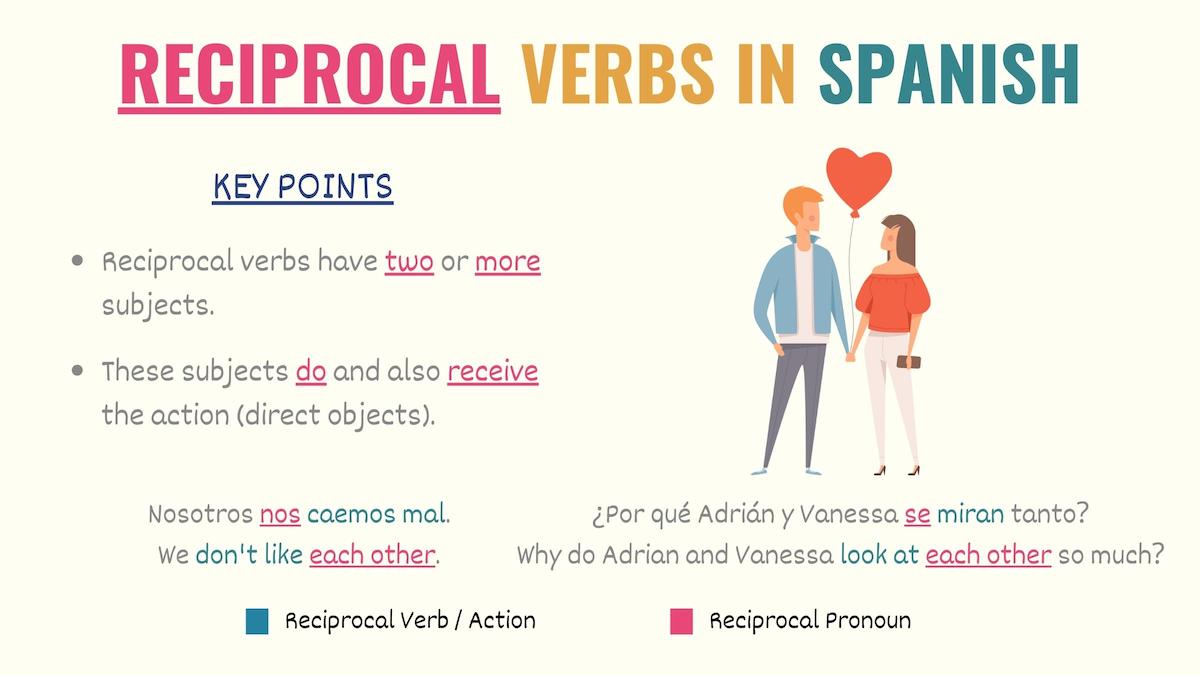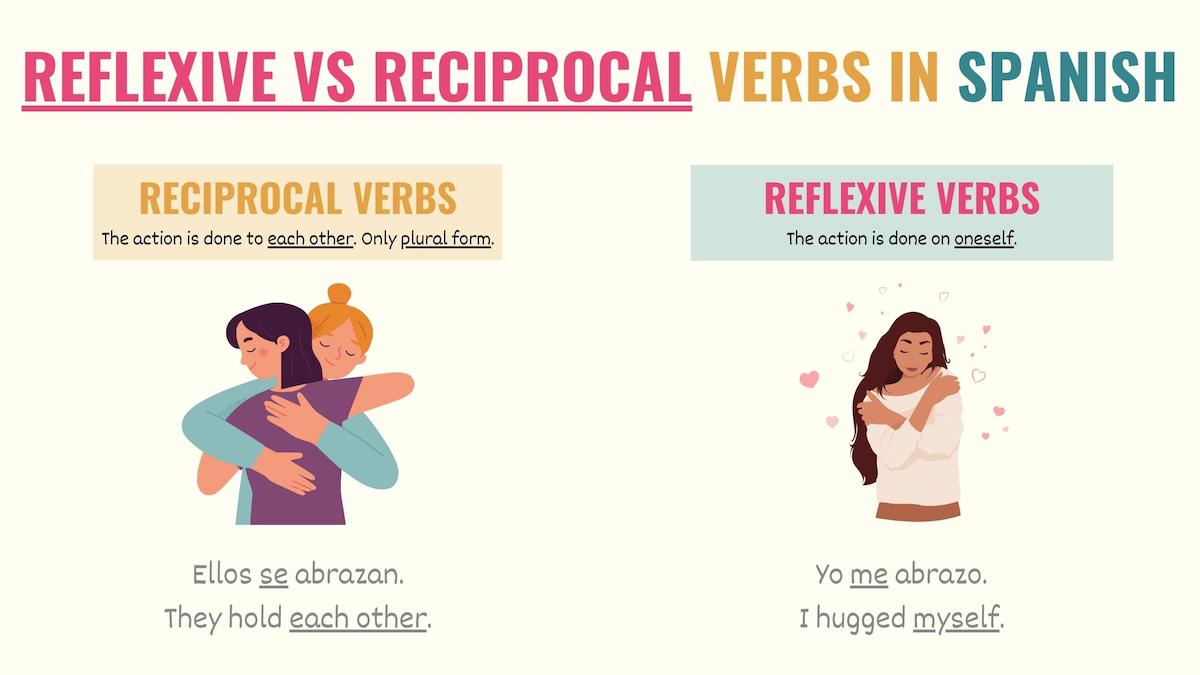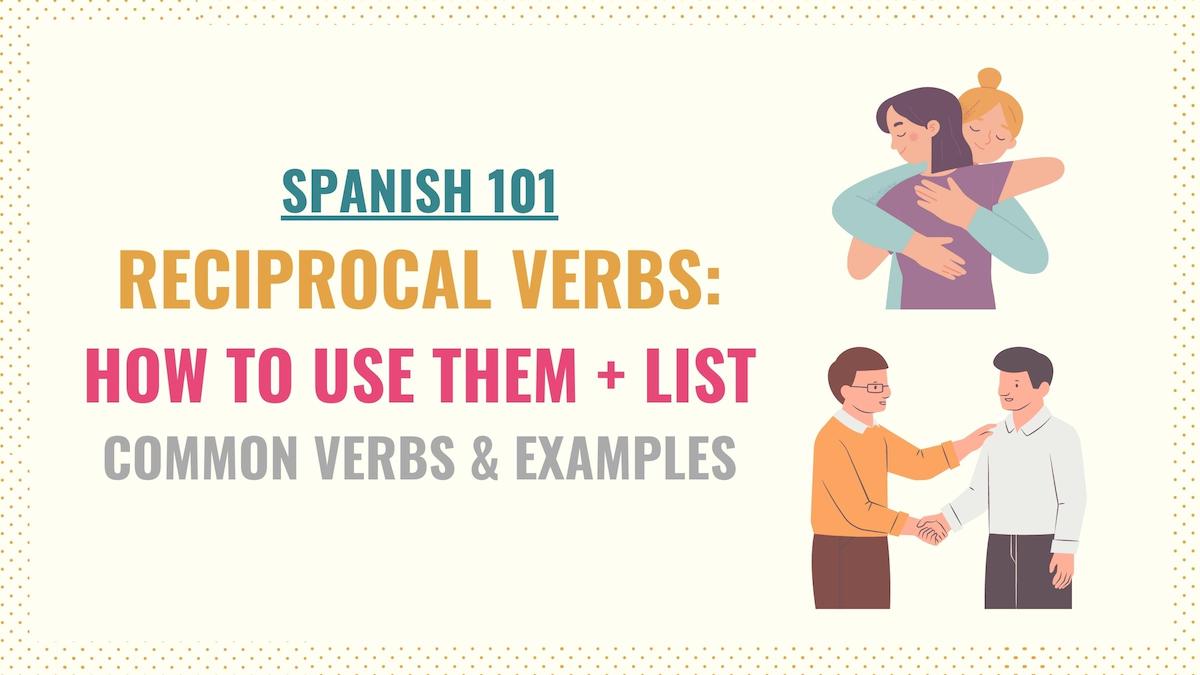Reciprocal verbs are used to talk about reciprocal actions in Spanish. In short, this type of verb is crucial for effective communication. So, in this reciprocal verbs Spanish guide, you’ll find:
- What Are Reciprocals & When to Use Them
- How to Conjugate Reciprocal Verbs
- List of Reciprocal Verbs
- Additional Resources
- Downloadable PDF Cheat Sheets
What Are Spanish Reciprocal Verbs?

Reciprocal verbs in Spanish indicate that two or more people perform an action upon each other (reciprocal action). Simply put, these verbs refer to a mutual or shared action between the subjects involved.
Here are several examples of reciprocal actions:
Nosotros siempre nos ayudamos.
We always help each other.
John y Allison se abrazaron.
John and Allison hugged each other.
In Spanish grammar, a reciprocal verb describes actions or events done by two or more subjects that are also the direct object. Take sentence #2 as an example.
In that sentence, abrazarse is used reciprocally. In simple words, this means that both John and Allison are doing (hugging) and receiving the action (being hugged).
Like other pronominal verbs in Spanish, reciprocal verbs end with the pronoun se (such as abrazarse). You’ll learn what this ending means in the conjugation section.
Take Note: You can only use these verbs if the action is reciprocated. If this is not the case, you must use direct object pronouns –yo la abrazo (I hug her).
Reciprocal vs reflexive verbs in Spanish
Reciprocals and reflexive verbs in Spanish are often confused because they both use reflexive pronouns, and their subject is also the object of the sentence. However, these verbs are not the same.
In Spanish, a reflexive verb conveys a reflexive action. Simply put, they communicate that the subject performs the action on oneself. On the other hand, a reciprocal verb in Spanish expresses a mutual action, something we do upon each other.
Check these reciprocal and reflexive sentences:
| Reflexive action | Reciprocal action |
|---|---|
| Nosotros nos bañamos con agua fría. We shower with cold water. | Nos queremos mucho. We loved each other so much. |
A reflexive verb (sentence on the left), describes actions people (subjects) do on themselves. This example refers to our daily routine. Reflexive verbs can have singular or plural subjects.
However, reciprocal verbs in Spanish always come in plural form because they communicate that two or more participants perform and receive an action.

Take Note: In Spanish, not all verbs ending in se are necessarily reflexive or reciprocal. Some verbs require a pronominal pronoun to keep their meaning. They’re called idiomatic pronominal verbs.
How to Conjugate Reciprocal Verbs & Use Pronouns
Reciprocal verbs in Spanish always use plural conjugations. Additionally, you must also use the corresponding reciprocal pronoun.
In Spanish, the reciprocal pronouns are:
- (Nosotros) Nos
- (Vosotros) Os
- (Ellos / Ellas / Ustedes) Se
Take Note: You can use the acronym NOSE (no sé) to remember these pronouns.
Aside from this, you’ll follow the same steps you’ll use to conjugate reflexive verbs in Spanish. Remove the infinitive ending and add the tense endings you need. Check this conjugation table in the present form:
| Saludarse | Quererse | Despedirse |
|---|---|---|
| Nosotros nos saludamos | Nosotros nos queremos | Nosotros nos despedimos |
| Vosotros os saludáis | Vosotros os queréis | Vosotros os despedís |
| Ellos se saludan | Ellos se quieren | Ellos se despiden |
A reciprocal verb in Spanish is the equivalent of the English reciprocal pronouns “each other” or “one other”. For the most part, this is the translation you’ll use. However, there might be some occasions where an English sentence doesn’t need to include these words.
Take Note: Depending on the context, ‘each other’ can also be translated as: uno al otro, entre ellos, entre nosotros, mutuamente (mutually). These expressions can be added to your reciprocal sentence. However, its only purpose is to intensify it since you’re already expressing reciprocity with the pronouns.
Vosotros os ayudáis uno al otro todo el tiempo.
You guys help each other all the time.
Reflexive Pronouns vs Reciprocal Pronouns
As you learn Spanish grammar, you’ll realize that Spanish is inundated with a plethora of different types of pronouns. The good news is that pronouns for reciprocal and reflexive verbs overlap, so you only need to understand the two sets and the rule.
| Subject | Reflexive Pronoun | Reciprocal Pronoun |
|---|---|---|
| Yo | Me | – |
| Tú | Te | – |
| Él / Ella / Usted | Se | – |
| Nosotros | Nos | Nos |
| Vosotros | Os | Os |
| Ellos / Ellas / Ustedes | Se | Se |
The table above shows the two sets of pronouns so you can quickly see which are used for reflexive verbs and reciprocals, respectively. As you can see, plural pronouns are used for both.
However, reflexive verbs can also use singular pronouns since an individual person can perform an action on him- or herself whereas reciprocal actions can only be performed on 2 or more people (each other).
List of Common Reciprocal Verbs in Spanish
Now that you understand what these verbs are and how to use them, here is a list of common reciprocal verbs in Spanish:
- Abrazarse: To hug / To hold
- Amarse: To love
- Apoyarse: To support
- Ayudarse: To help
- Besarse: To kiss
- Conocerse: To meet / To know
- Despedirse: To say goodbye
- Entenderse: To understand
- Extrañarse: To miss
- Felicitarse: To congratulate
- Ignorarse: To ignore
- Insultarse: To insult
- Llevarse: To get along
- Motivarse: To motivate
- Odiarse: To hate
- Pelearse: To argue / To fight
- Perdonarse: To forgive
- Quererse: To love
- Reconciliarse: To reconcile
- Respetarse: To respect
- Saludarse: To greet
- Tocarse: To touch
Here are some reciprocal sentences:
Vosotros os motiváis a ser mejores.
You guys motivate each other to be better.
Luis y James nunca se llevaron bien.
Luis and James never liked each other.
¿Cómo se conocieron mi papá y tú?
How did you and dad meet?
David y Nancy se ignoraron todo el día.
David and Nancy ignored each other all day.
Mis amigas y yo nos queremos mucho.
My friends and I love each other very much.
Take Note: Reciprocals are transitive verbs, which means they take an object which is also the subject of the sentence. As established before, if the action is not reciprocated, you will use a direct object.
Reciprocal Verbs Spanish Resources
Here are some useful links to help you get more comfortable with this topic. For starters, get familiar with reflexive pronouns (also called pronominal) since you’ll use some of them with reciprocal verbs.
Also, check how to conjugate reflexive verbs in Spanish. This will help you understand what to do when conjugating a reciprocal verb. In fact, the following conjugation guide will show you how to conjugate these verbs in different tenses:
Remember that you only need to pay attention to the plural forms (nosotros, vosotros, etc) with reciprocals.
Before diving deeper into other parts of grammar, you can also check out the Spanish verbs guide which gives a complete overview of everything you need to know.
Download the Spanish Reciprocal Verbs PDF Cheat Sheet
Grammar topics like Spanish reflexive verbs and reciprocals can be challenging for new learners to understand. However, it is a Spanish beginner topic that is critical to your conversation skills and fluency. I’ve compiled a free PDF you can download on reciprocal verbs and pronouns, where you’ll get the list of reciprocal actions, understand the key differences between reflexive verbs and pronouns and the reciprocals and more.



